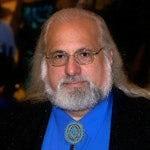Meta's Investment In Data Center Geothermal Power Is Just the Latest In Clean Energy for Hyperscalers
In the search for carbon-free, sustainable, reliable energy generation, hyperscalers are leaving no stone unturned.
Literally, it seems -- as Meta announced last week at the U.S. Department of Energy’s Catalyzing Next Generation Geothermal Development Workshop that it was partnering with Sage Geosystems to deploy the proprietary Sage Geopressure Geothermal System (GGS) as a future clean energy source for its data centers.
Meta’s partnership plan is to deliver up to 150 MW of baseload power in the US from the Sage GGS for data center operations, with the initial stage of the project to come online in 2027.
Geothermal power generation is not a new methodology of energy deployment, but the Sage GGS system represents a new technology for getting usable power from geothermal generation.
Cindy Taff, CEO of Sage Geosystems, put the announcement in context:
“We are thrilled to be at the forefront of the next generation of geothermal technology and applaud the DOE for supporting the commercialization of innovation solutions. As energy demand continues to grow, the need for reliable, resilient and sustainable power is paramount, and our partnership with Meta underscores the critical need for innovative and sustainable energy solutions like ours.”
Geothermal Overview
Traditionally, geothermal power is produced in areas that provide easy access to the heat naturally generated by the planet. This is usually thought of in areas that are also known for volcanic activity.
For example, Iceland generates approximately 6,000 GW of power annually via geothermal generating stations, the largest of which, the Hellisheiði Geothermal Power Plant, outside of the capital of Reykjavik, generates 303 MW of power while also providing more than 130 MW of thermal energy, used primarily in heating homes and businesses in the region.
But the number of areas that are suitable for this type of power generation, especially in the US, are severely limited.
California and Nevada, where the temperature differential used for geothermal power generation is close to the surface and easily accessed, are the top two of the seven US states with geothermal energy production. The two are responsible for over 92% of the power generated by geothermal sources in the US, according to the US Energy Information Administration.
It should be noted that the 17 billion kWH presently generated by geothermal in the US accounts for less than half of one percent of US energy generation annually.
What Makes GGS Unique?
The Sage GGS technology's advantage is that it makes use of both temperature and pressure, not just temperature, and does not require volcanic activity or deep drilling to harvest the heat necessary to be used to generate power.
By combining heat and pressure, Sage can double the energy output when compared to traditional geothermal generation systems.
This also means that areas that would not be suitable for a traditional geothermal plant can be used for power generation using the GGS approach.
Sage claims that their technology, field-tested since 2022, uses hot dry rock formations, which are much more abundant, compared to traditional hydrothermal formations used by existing technologies.
This means that the GGS system can be deployed virtually anywhere, and the abundance of appropriate geological structures should allow for the rapid expansion of this type of clean, carbon-free, geothermal power generation across the US.
The fundamental technology for developing the geothermal sites is derived from the decades of expertise in drilling for oil and gas that is available from the fossil fuel industry.
Contrasting Google and Fervo
For industry watchers paying close attention, you may recall that at the end of 2023 we reported on a project we initially covered in 2021: Google’s partnership with geothermal power producer Fervo Energy to provide power to run Google’s data centers.
What we didn’t discuss was how much power this first-generation project, using Fervo’s Enhanced Geothermal Systems (EGS), was adding to the nation's power availability.
Rather than report on the power being generated, the focus of this project seems to be to address the potential issues with setting up and running the EGS power plant and to operate as a proof of concept.
The EGS technology forces water into hot rock formations to improve the flow of heat to the surface, and like GGS, can allow energy extraction from areas where the natural hydrothermal resources are insufficient.
The technology, derived from current oil and gas drilling, also includes horizontal drilling techniques, which allow for the creation of multiple wells in a single location, reducing the potential surface footprint.
Shortly before Google made their announcement about the inclusion of the Fervo-generated power in its portfolio, Fervo announced the ground-breaking of their 400 MW Cape Station project in southwest Utah.
With an ambitious goal of delivering power to the grid by 2026 and the full 400 MW of production by 2028, development of the site continues, with the company raising an additional $244 million earlier this year for the project.
The Next Generation of Power Generation
Advanced geothermal power technologies aren’t facing the legacy concerns that advanced nuclear reactor developments see, or the concerns over distributing the fuel that clean hydrogen power has been facing.
But all of these next-generation carbon-free clean power sources that hyperscalers and the data center industry are looking toward to aid in the quest for zero-carbon operations by 2050, and developing a more sustainable future, face similar hurdles.
The methodologies for streamlining the permitting and the approval processes for all of these new technologies don’t have the same well-trodden paths that wind, solar, or even the fossil fuel industry already have before them.
All of these industries would benefit from a clearer approval process, from the Federal government on down, so that all the benefits these next-generation clean energy technologies can bring don’t get bogged down in a bureaucratic or NIMBY mindset.






